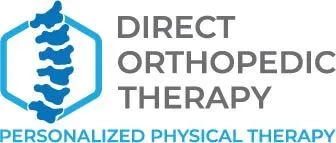Pelvic Organ Prolapse in Jacksonville Beach

Finding Relief from Pelvic Organ Prolapse in Jacksonville Beach
Living with pelvic organ prolapse can make daily life painfully uncomfortable. You may struggle with issues like incontinence, painful intercourse, constipation, or a persistent heavy feeling in your pelvis.
If this sounds familiar, you’re not alone. Pelvic organ prolapse affects 25% of women at some point in their lives. But despite how common it is, many women suffer in silence.
The good news? There are treatment options available, including pelvic floor physical therapy at Direct Orthopedic Therapy in Jacksonville Beach. Keep reading to see if this gentle, non-invasive approach could help provide the relief you’ve been searching for.
A Hidden Condition That Doesn’t Have To Hold You Back
Pelvic organ prolapse happens when the muscles and tissues of your pelvic floor become weak or damaged, often due to pregnancy, childbirth, menopause or aging. When this important system of support breaks down, the organs in your pelvis (like your bladder, uterus or rectum) can start to descend or bulge into the vagina.
This causes a variety of frustrating and embarrassing symptoms, like:
- Pressure or heaviness in the pelvis
- A feeling like something is falling out
- Seeing or feeling a bulge at the vaginal opening
- Trouble urinating
- Incontinence
- Constipation
- Painful intercourse
Understandably, many women don’t want to talk about these sensitive issues. But suffering in silence often means the symptoms get worse over time.
The truth is pelvic organ prolapse is treatable. And one of the most effective options is pelvic floor physical therapy at Direct Orthopedic Therapy.
Pelvic Floor Therapy: A Game Changer for Prolapse
Pelvic floor physical therapy works by strengthening and retraining the muscles that support your pelvic organs.
A skilled pelvic health PT will create a customized program using techniques like:
- Biofeedback
- Soft tissue mobilization
- Kegel exercises
- Electrical stimulation
- Behavior modifications
- Exercise/movement education
These methods help reconstruct the “hammock” that keeps your pelvic organs lifted and functioning properly.
By the end of your treatment plan, you’ll have stronger pelvic floor muscles along with the tools to manage symptoms and prevent prolapse from progressing or recurring.
Pelvic floor therapy offers life-changing benefits like:
Reduced Symptoms
- 74% of women see reduced prolapse symptoms with pelvic floor PT
- 83% experience less pelvic pain and pressure
- 75% improve or resolve bladder control problems
Improved Quality of Life
When pelvic organ prolapse interferes with enjoying daily activities, relationships, work and hobbies, quality of life suffers. Pelvic floor therapy aims to restore comfort and confidence from the inside out.
In studies, pelvic floor PT led to:
- 89% improvement in ability to do household chores
- 81% improvement in physical activity participation
- 76% improvement in social activities
- 75% improvement in emotional well-being
Avoiding Surgery
1 in 3 women with pelvic organ prolapse ultimately have surgery to treat it. But clinical studies show pelvic floor therapy should be the first-line treatment:
Pelvic floor therapy sees similar treatment effects as surgery, without the risks of complications or lengthy recovery times
22% of surgery patients require additional treatment for recurring prolapse symptoms within 4 years
Pelvic floor therapy is an effective way to manage symptoms long-term while avoiding repeat surgeries.
Better Sexual Function
Pelvic organ prolapse can contribute to low libido, arousal difficulties and painful intercourse. But strengthening the pelvic floor muscles through therapy can pay big dividends in the bedroom:
- 62% of women see improved sexual function with pelvic floor PT
- 75% experience less discomfort during sex
- 60% improvement in overall sexual satisfaction
What To Expect During Pelvic Floor Therapy Sessions
Wondering what happens during a pelvic floor therapy visit? The good news is sessions focus on equipping you with skills – not just passive treatment. You’ll learn techniques to reduce symptoms now while gaining control over your health long-term.
Each 60-90 minute session includes:
- External soft tissue work:
Your therapist will gently work to mobilize tight muscles and fascia around your hips, abs, low back and tailbone. This hands-on work preps your body to activate the deep pelvic floor muscles effectively.
Pro tip: You’ll be in comfortable shorts and can request a sheet over your lower half during this part of the session. - Biofeedback training:
Using sensors and visualization tools, your PT helps you locate and contract the muscles that have become weak or “turned off” from prolapse. With coaching and feedback, you’ll learn to engage the muscles properly again. - Pelvic floor exercises:
Practice makes perfect when it comes to strengthening pelvic muscles. Your PT will teach you a customized routine of Kegels, diaphragmatic breathing and core exercises you can do at home. - Internal manual therapy (optional):
Some patients experience increased benefits from gentle internal soft tissue and trigger point release. This is always optional – just let your therapist know if you’d like to incorporate it.
Along the way, your PT will provide coaching to improve pelvic alignment, movement patterns and helpful behavioral modifications. You’ll also discuss lifestyle factors like nutrition and hydration that support your progress.
Frequently Asked Questions About Pelvic Floor Physical Therapy
If you’re considering pelvic floor therapy, you probably still have some questions. Here are answers to some of the key topics that often come up:
What happens during a pelvic floor PT session?
Sessions incorporate external and internal hands-on techniques, biofeedback training, exercise instruction and lifestyle coaching. You’ll be covered with sheets or shorts while working closely with your therapist to reduce symptoms and strengthen muscles.
What if I feel too uncomfortable to do certain parts of therapy?
That’s completely understandable! Just let your therapist know what you prefer to work on or avoid for now. You’re always in control of the treatment plan.
Can pelvic floor therapy help with organ prolapse after menopause or post-hysterectomy?
Absolutely. Strengthening and retraining pelvic floor muscles provides benefits at any age. Your therapist will tailor the techniques to meet your needs.
Still have questions? Reach out! We’re always happy to provide more details about how pelvic floor physical therapy works so you can make the most informed decision.
Meet Your Pelvic Health Team At Direct Orthopedic Therapy
Our skilled women’s health physical therapists have advanced training in pelvic floor dysfunction and decades of experience helping patients find relief from prolapse symptoms.
{Staff_Name}, {Credentials}
{1-2 sentence bio}
{Staff_Name}, {Credentials}
{1-2 sentence bio}
{Staff_Name}, {Credentials}
{1-2 sentence bio}
We provide compassionate, patient-centered care and partner closely with each woman to meet her unique needs and goals.
Take The First Step Toward Relief
If you’re dealing with the discomfort of pelvic organ prolapse, we understand how much it can disrupt your life. But you don’t have to keep suffering in silence – there are solutions.
Pelvic floor physical therapy is a low-risk way to start reducing your symptoms while you regain control of your health. We offer flexible scheduling options to fit your busy life. Give us a call at {phone number} or request an appointment online to get started. We can’t wait to help you reclaim your quality of life!


